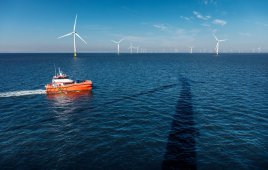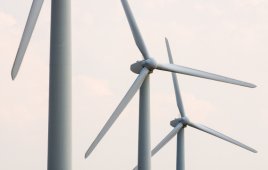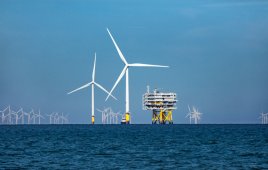
For turbines rated over 394 kW, such as 500, 750, 1,000, 1,200 kW, the company uses multiple generators which are commercially available in a wide range of outputs.
After finding that the wind industry had been working with less than up-to-date technology in its generators, WindPower Innovations CTO Ian Griffiths set about to find a more efficient design. The company’s business has been refurbishing older wind turbines, such as those from former OEM Micon which built turbines that produced less than 500 kW. “We already knew of 48 and 54 pole, slow-speed motors. Why not just as many poles in a slow speed generator?” he asks.
With assistance from the engineers at his subsidiary, Energetic Drives LLC, in Portland, Oregon, Griffiths’ team devised solutions for a range of low-speed, direct drive generators capable of up to 400 kW. “These permanent-magnet generators are also certified for low noise, addressing one of the biggest environmental objections facing the wind industry.”
The new generators payoff with increased up-time by trimming maintenance and repairs to just 25% of former requirements. “The PM generators and a grid-tie inverter can now produce a constant 60Hz ac power over a wider band of operation than traditional generators, from 20 to 125% of rated power. Conventional generators only have one or two power synchronization peaks (±5%) that can produce the 60Hz ac required by the grid. It’s also smart technology in that it senses variable load demands and adjust power output.”
The group also built a single-stage gearbox that can drive up to four generators, giving the company a drive train ready for a 1.2 to 1.6-MW turbine.

Permanent-magnet or PM motors and generators used in Energetic Drives’ systems (right) measure about 31 x 31 x 46 in. The conventional generator of similar output (lower left) measures about 66 x 45 x 74 in.
“Even though we can go direct drive up to 400kW, depending on the refurbished turbine design and its location, we occasionally find the gearbox allows producing over 200% more power over a direct drive, particularly in mean wind speeds of 18 mph,” says Griffiths.
He says the gearbox is something like an automobile transmission in that it has a ratio of about 3.866:1 and produces an output speed of about 145 rpm for the company generators. “This keeps heat and wear-particle generation low. And like the differential in a car, the device needs little maintenance,” he says.
Gear ratios in conventional gearboxes are typically rounded such as 4:1 or 5:1. Such a design increases wear on the teeth because for every 4 or 5 rotations, the same teeth contact. In a 3.886:1 gearbox, however, the same teeth would align about every 680 rotations, which minimizes tooth wear.
In addition, Griffiths says his team has looked at rotor dynamics for improvements. He acknowledge that the industry has recognized the value of pitch control, but counts few up-to-date systems. “It is possible to better control blade pitch using a $250 off-the-shelf, PID-loop controller and a fuzzy-logic algorithm. It’s called a shear-wind model, adaptive tuning. This allows adjusting the pitch in a full rotation to capture more energy.”

Two, two-stage gearboxes share components and keep tooth stresses low by taking power off in several places. Lubrication is simple and it needs no special cooling. Sharing components in both designs allows reducing inventory.

The cutaway of Energetic Drives’ single stage gearbox bumps input speed by about 3.886:1, enough to turn a 330 kW PM generator. The relatively low speed (145 rpm) on the input shaft produces little noise and needs only simple lubrication.
Filed Under: Generators, O&M




It’s good to see a company utilizing the permanent magnet design outside of the big 4, GE, Siemens, Vestas and Enercon.
Energetic Drives is a Portland OR based company and I happen to believe, American Entrepreneurship works. Lets hope the big guys don’t legislate small companies out of the business by imposing unnecessary burdens on the certification of turbines in the near future.
This article proves Americans can compete if we allow them to.
Thanks
Wayne Cree.